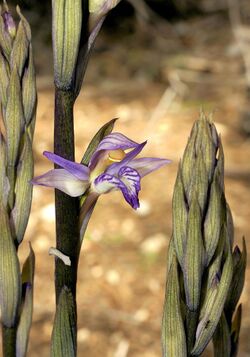Biology:Limodorum
| Limodorum | |
|---|---|

| |
| Limodorum abortivum | |
| Scientific classification | |
| Kingdom: | Plantae |
| Clade: | Tracheophytes |
| Clade: | Angiosperms |
| Clade: | Monocots |
| Order: | Asparagales |
| Family: | Orchidaceae |
| Subfamily: | Epidendroideae |
| Tribe: | Neottieae |
| Genus: | Limodorum Boehm. (1760) |
| Type species | |
| Limodorum abortivum | |
| Synonyms[1] | |
| |
Limodorum is a genus of myco-heterotrophic orchids. All species are temperate terrestrial plants and occur across much of Europe, North-West Africa, the Mediterranean Islands, and as far east as Iran. [2] Plants have evolved away from photosynthesis and as a result their leaves are reduced to scales. There is still chlorophyll present but the plants are believed to be solely dependent on their fungal partner for nutrients.[3] They spend most of their life underground as a short stem with fleshy roots, the unbranched inflorescence can appear in April to June if conditions are favourable. [4]
The name finds its origin in "haemodoron", first applied by Theophrastus and later adopted by Jacques Daléchamps to refer to parasitic plants most likely in Orobanche. [5] The name is derived from the Greek “leimo-” (meadow) and “dōron,” (gift). [6]
Species
A very long list of names has been proposed over the years. Most of these species, once part of Limodorum, have been transferred to other genera. There are currently three recognised species in Limodorum:[1][7]
- Limodorum abortivum (L.) Swartz - Central Europe, the Mediterranean region as far east as Iran and the Caucasus
- Limodorum trabutianum Bartolo & Pulv. - Turkey
- Limodorum rubriflorum Batt. - Spain, Portugal, Balearic Islands, Sardinia, Sicily, mainland Italy, Algeria, Morocco
See also
References
- ↑ 1.0 1.1 Kew World Checklist of Selected Plant Families
- ↑ "Limodorum Boehm.". Royal Botanical Gardens Kew. https://powo.science.kew.org/taxon/urn:lsid:ipni.org:names:29861-1.
- ↑ Girlanda, M.; Selosse, M. A.; Cafasso, D.; Brilli, F.; Delfine, S.; Fabbian, R.; Ghignone, S.; Pinelli, P. et al. (2005-12-05). "Inefficient photosynthesis in the Mediterranean orchid Limodorum abortivum is mirrored by specific association to ectomycorrhizal Russulaceae: MYCORRHIZAL SPECIFICITY IN LIMODORUM" (in en). Molecular Ecology 15 (2): 491–504. doi:10.1111/j.1365-294X.2005.02770.x. https://onlinelibrary.wiley.com/doi/10.1111/j.1365-294X.2005.02770.x.
- ↑ Alrich, Peggy; Higgins, Wesley (September 2015). "Limodorum: An Old World Genus". Orchids (www.aos.org): 535. https://www.researchgate.net/publication/290816596_Limodorum_An_Old_World_Genus.
- ↑ Uhlich, Holger (2014). "Geschichte der Erforschung der Sommerwurzgewächse (Gattungen Orobanche und Phelipanche)". Kochia 8: 32. http://www.flora-deutschlands.de/kochia8/kochia%208%20seiten%20027-061%20hr.pdf. Retrieved 25 April 2021.
- ↑ Alrich, Peggy; Higgins, Wesley (September 2015). "Limodorum: An Old World Genus". Orchids (www.aos.org): 535. https://www.researchgate.net/publication/290816596_Limodorum_An_Old_World_Genus.
- ↑ Altervista Flora Italiana, Fior di legna, Violet Limodore, Limodorum abortivum (L.) Swartz
- Boehmer, G.R. (1760) Definitiones Generum Plantarum 358.
- Pridgeon, A.M., Cribb, P.J., Chase, M.C. & Rasmussen, F.N. (2006) Epidendroideae (Part One). Genera Orchidacearum 4: 506 ff. Oxford University Press.
External links
Wikidata ☰ Q159414 entry
 |

